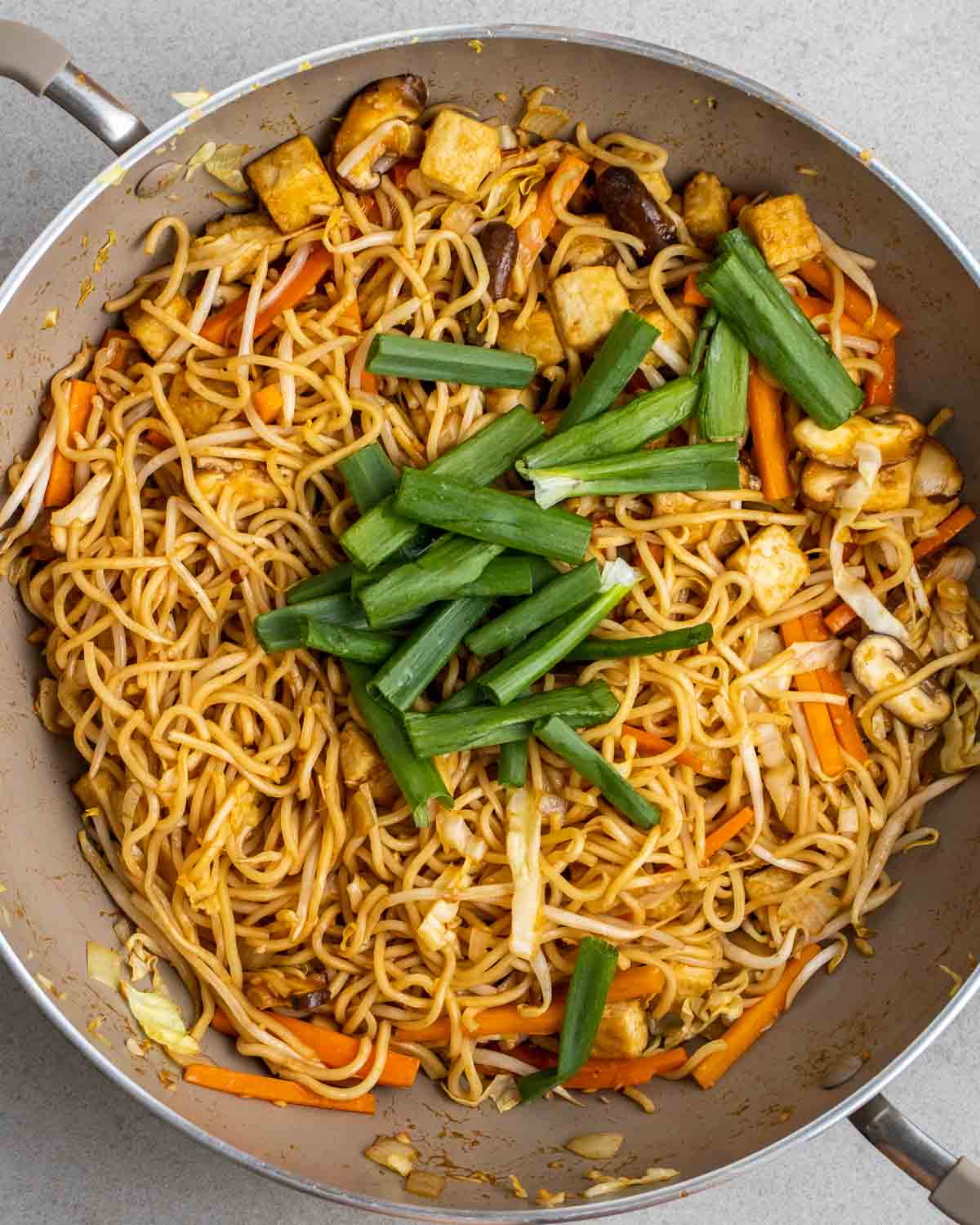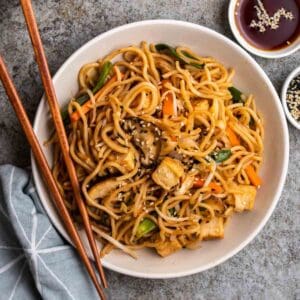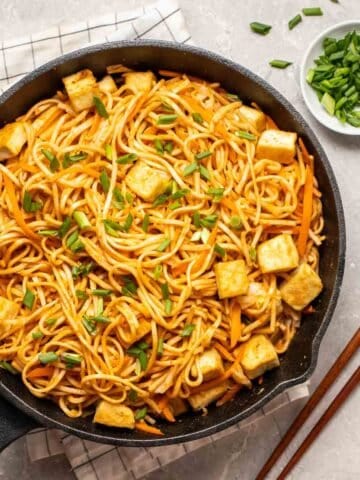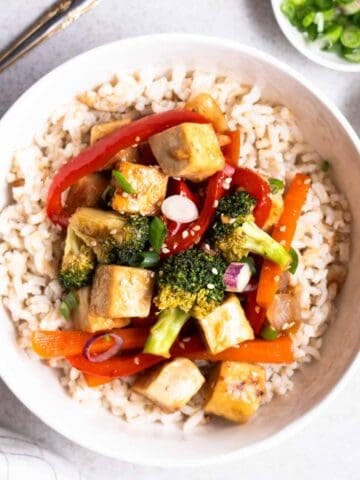This vegan yakisoba features chewy noodles, tofu, and vibrant veggies cooked in a sweet and savory sauce. Ready in 30 minutes, this dish is the perfect easy weeknight dinner. Gluten-free options are provided too!

Here is the vegan version of the Japanese’s classic yakisoba! It is incredibly flavorful and filling yet healthy at the same time. This vegan yakisoba has been on my weekly meal rotation ever since I discovered it!
Jump to:
💚Why you will love this recipe
- Hearty, delicious, and jam-packed with flavors
- Quick and easy to make - ready in 30 minutes
- Highly customizable - most ingredients in this recipe are swappable!
- A delicious way to get in your daily dose of vegetables
🤔What is yakisoba
Yakisoba is the Japanese version of stir-fried noodles. It is usually made with Chinese wheat noodles, vegetables like mushrooms, bean sprouts, and onion, and pieces of thinly-sliced meat. Everything is tossed in yakisoba sauce with a sweet, savory, and savory profile.
This dish is popular Japanese street food and can be found in food stores, convenience stores, or even school canteens. It is typically served as a main dish but can also be used as a stuffing for hot dog buns!
In this vegan version, we will make yakisoba sauce from scratch and replace the meat with some pan-fried tofu.
🍜What noodles to use in yakisoba
Although ‘yaki soba’ might be directly translated to ‘fried buckwheat noodles,’ this dish is commonly made with yellow wheat noodles. In actual fact, soba is used to describe any type of noodles in Japanese.
Unlike egg noodles, yakisoba noodles are yellow due to the use of Kansui (lye water) and do not contain eggs, hence are suitable for vegans. It usually comes vacuum-packed and can be found in most well-stocked groceries or your local Asian market. They are typically located in the fridge or freezer section.
Some great substitutes for yakisoba noodles include ramen, glass noodles, rice noodles, or soba. Just make sure to cook them according to the instructions on the package before using them.
🧄What you will need



📃Ingredients notes and substitutions
- Yakisoba noodles - As mentioned above, you can use other noodles like ramen, soba, rice noodles, or glass noodles. Just make sure to cook them before adding them to the stir-fry.
- Oyster sauce - Use vegetarian ones to keep this dish vegan.
- I am using Lee Kum Kee ones. Although it is labeled as '' stir-fry sauce'', it is essentially vegetarian oyster sauce and contains mushroom extracts.
- Feel free to substitute it with more soy sauce, but you might need less of it.
- Worcestershire sauce - Make sure to use a vegan one, as fish sauce is commonly added to this condiment. Alternatively, you can just substitute it with 1 tablespoon ketchup, 1 tablespoon rice wine vinegar, and ½ tablespoon soy sauce.
Save this recipe!
Also get a FREE high-protein vegan recipe eBook + weekly new recipes! Unsubscribe anytime.
🔪How to make
In a bowl, combine all condiments to make yakisoba sauce. Set aside.
In a container, place tofu cubes along with cornstarch and salt. Place the lid on and toss the container until tofu cubes are well coated.
Heat a tablespoon of oil in a non-stick wok/skillet over medium-high. Pan-fry tofu for 2-3 minutes on each side or until most sides are golden. Set aside for later use.


Heat another tablespoon of oil in the same wok. Add onion and saute for a few minutes until translucent.
Stir in garlic and fry for another minute until fragrant.


Add the carrot and saute for 2-3 minutes, or until slightly softened. Add cabbage and mushrooms next, and cook for 3-4 minutes, or until the veggies are tender.


Add noodles, bean sprouts, pan-fried tofu, and yakisoba sauce to the wok. Toss to combine and fry for 1-2 minutes, or until everything is hot.
Remove from heat, then stir in green onions. Your vegan yakisoba noodles is ready to be served!


🎥Watch how to make it
✔Helpful tips
- Loosen up your noodles in warm water using your hands or a pair of chopsticks before use. This is to prevent them from breaking during the stir-frying process.
- Use a big enough wok or pan to cook your vegan yakisoba to ensure that all ingredients are evenly cooked.
- Stir-fry your vegetables according to the order suggested in this recipe. This is to prevent soggy vegetables, as different veggies have different cooking times.
- To make this recipe gluten-free, opt for glass noodles or 100% buckwheat noodles.
- Leftovers can be refrigerated for up to 4 days. You might need to add a splash of water when reheating if the noodles appear dry.
✨Variations
Vegetables - Feel free to substitute the veggies used in this recipe with whatever you have on hand. Bell peppers, broccoli, snap peas, and baby corns are some veggies that work great in stir-fries. However, I would not suggest leaving out the onions and mushrooms as they give vegan yakisoba tons of flavors.
Tofu - If you are not a fan, replace it with tempeh or chunks of vegan chicken breast.
Toppings - Gives your vegan yakisoba extra flavor and texture. Chopped green onion, red pepper flakes, and toasted sesame seeds are my go-to, but you could use aonori (toasted seaweed flakes) or pickled ginger for a more authentic version.

❔Commonly asked questions
Yakisoba is not spicy and can be enjoyed by children and adults alike. However, if you love spice, feel free to top it with some sriracha or red pepper flakes.
Yakisoba noodles and soba noodles are different. The former is Chinese-inspired yellow wheat noodles, while the latter is usually made from buckwheat. Yakisoba is also traditionally sold cooked and can be added to stir-fries straight away, while most soba noodles come in the dehydrated form and must be boiled before use.

📖 Recipe

Vegan Yakisoba with Tofu
Ingredients
For tofu
- 1 block extra firm tofu drained, pressed, and cubed (14oz/400g)
- 1 tablespoon cornstarch
- ½ teaspoon salt
For yakisoba sauce
- 2 tablespoon ketchup
- 2 tablespoons vegan worcestershire sauce **
- 1 tablespoon soy sauce or tamari/shoyu (use gluten-free if needed)
- 1 tablespoon vegetarian oyster sauce ***
- ½ tablespoon maple syrup or other sweetener (optional)
For stir-fry
- 16 oz yakisoba noodles (or 7 oz dry noodles of choice, see notes)*
- ½ yellow onion diced
- 3 cloves garlic minced
- 1 medium carrot julienned
- 6-8 shiitake mushrooms
- 2 cups shredded cabbage
- 1 cup bean sprout
- 1 stalk green onion cut into 2 inches pieces
Instructions
- In a container, place in tofu cubes along with cornstarch and salt. Place the lid on and toss the container until tofu cubes are well coated.
- Heat up a tablespoon of oil in a non-stick wok/skillet over medium-high. Pan-fry tofu for 2-3 minutes on each side, or until most sides are golden. Set aside for later use.
- In a bowl, combine together all condiments to make yakisoba sauce. Set aside.
- Heat up another tablespoon of oil in the same wok. Add onion and saute for a few minutes until translucent.
- Stir in garlic and fry for another minute until fragrant.
- Now, add the carrot and saute for 2-3 minutes, or until slightly softened. Add cabbage and mushrooms next, and cook for 3-4 minutes, or until the veggies are tender.
- Add noodles, bean sprouts, and pan-fried tofu along with yakisoba sauce to the wok. Toss to combine and fry for 1-2 minutes, or until everything is hot.
- Remove from heat, then stir in green onions. Give it a taste, and add more soy sauce if needed. Your vegan yakisoba noodles is ready to be served!
Video
Notes
- I am using Lee Kum Kee ones. Although it is labeled as '' stir-fry sauce'', it is essentially vegetarian oyster sauce and contains mushroom extracts.
- Feel free to substitute it with more soy sauce, but you might need less of it.
- Loosen up your noodles in warm water using your hands or a pair of chopsticks before use. This is to prevent them from breaking during the stir-frying process.
- To make this recipe gluten-free, opt for glass noodles or 100% buckwheat noodles.
- To lower the sodium content of this meal, simply use a low-sodium soy sauce.
- Leftovers can be refrigerated for up to 4 days. You might need to add a splash of water when reheating if the noodles appear dry.
Save this recipe!
Also get a FREE high-protein vegan recipe eBook + weekly new recipes! Unsubscribe anytime.
Nutrition
Nutrition info calculated is just a rough estimate and is provided as a courtesy. Bear in mind that value will vary based on variables like specific brand or type of product used. To obtain the most accurate representation, it is highly recommended that you calculate it on your own with the actual amount and type of ingredient used.









Join the discussion !